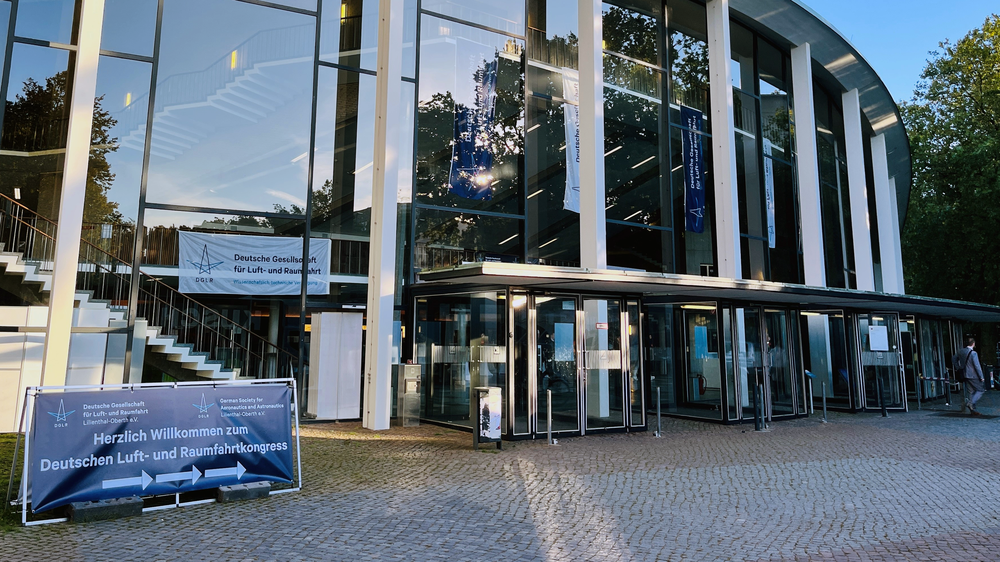DLR Institute of Air Transport at the DLRK 2024

- Scientific contribution to the EU-MRV system for non-CO2 emissions in air transport
- Cabin systems: Optimising passenger and operational experience
- Safety performance of alternative navigation systems in European airspace
- Efficient aircraft evaluation using the CPACS configuration scheme
DLRK 2024: DLR Institute of Air Transport presents current research
The 73rd German Aerospace Congress (DLRK) in Hamburg, as the central event for the German-speaking aerospace community, brought together around 1,000 experts from the industry to discuss current developments and innovative solutions. The DLR Institute of Air Transport was represented in the specialist sessions with four contributions.
MRV system for non-CO2 climate effects in air transport
At the DLRK 2024, the institute presented the scientific research accompanying the introduction of a Europe-wide MRV system (Monitoring, Reporting, and Verification) for non-CO2 climate effects in air transport1. From January 2025, in addition to CO2 emissions, non-CO2 effects such as nitrogen oxides and contrails, will also need to be recorded by an MRV system in the EU, as they contribute significantly to global warming. Approximately two-thirds of the climate impact of aviation is caused by non-CO2 effects.
The research involved analysing suitable climate metrics and models for calculating CO2 equivalents for individual flights, defining the necessary data sets, and collaborating with relevant stakeholders to provide this data. The CO2 equivalents are calculated either automatically by a central authority or directly by the airline operator. A two-step, climatological and weather-based approach was proposed for the calculation. The weather-based approach allows for more precise calculation of CO2 equivalents, while a climatological approach simplifies reporting for smaller emitters.
The emerging MRV system helps to better quantify the climate impact of flights and gradually reduce scientific uncertainties. These advancements are essential to better incorporate the entire climate impact of aviation into the EU Emissions Trading System (ETS) in the future.
User-centred development of aircraft cabin systems
The institute also presented a study on the user-centred development of cabin systems2. A new methodological approach was introduced, aiming to consider the needs of both passengers and airlines. As an example, the development of an intelligent lavatory system with touchless features was presented. By conducting targeted surveys of passengers and cabin crew, usage experiences and requirements were identified and incorporated into the technical development. The results of this analysis led to the creation of a prototype. This approach demonstrates how integrating user feedback into aircraft development can significantly enhance customer satisfaction.
Safety assessment of navigation systems
Another study presented examines the interaction between navigation performance and safety in European airspace3. This work compares the characteristics of an alternative performance-based navigation system with a system that uses fixed global performance standards for navigation. The study investigates how this alternative system affects a representative safety metric in European airspace. The aim of the analysis was to assess the system’s performance in terms of its operational value in highly congested airspaces. The results provide a thorough evaluation of the navigation system's suitability for use in areas with increased traffic complexity and highlight the importance of precise navigation for optimising air traffic management processes.
Application of CPACS in aircraft evaluation
The fourth presentation, in collaboration with Bauhaus Luftfahrt e. V., focused on the application and further development of the “Common Parametric Aircraft Configuration Schema” (CPACS) for the evaluation of aircraft designs4. CPACS, a data exchange format developed by the DLR Institute of System Architectures in Aeronautics, is used both within the DLR and with external partners. In the DLR projects ALICIA and EXACT, CPACS demonstrates its advantages in the comprehensive evaluation of aircraft concepts. The presentation, part of a special session celebrating the 20th anniversary of CPACS, illustrated how CPACS serves as a central interface supporting interdisciplinary collaboration in aircraft design and evaluation. Practical application examples include new technologies such as hydrogen propulsion and turbofan engines with water injection, as well as their evaluation concerning operating costs and environmental impacts. These examples show how CPACS can be flexibly integrated into the software design process and adapted to specific needs.
1 M. Niklaß (DLR Institute of Air Transport), R. Eichinger, V. Grewe, K. Dahlmann (DLR Institute of Atmospheric Physics), A. Lau, J. Scheelhaase, F. Wozny, F. Linke (DLR Institute of Air Transport), M. Plohr (DLR Institute of Propulsion Technology), L. Megill, S. Matthes, D. Piontek, C. Voigt (DLR Institute of Atmospheric Physics), V. de Haes, M. Jesus, E. Rodriguez, M. Tielrooij (To70, The Hague, Netherlands), I. Brumby, R. Koster and L. Natera Orozco (Aerlabs, Rotterdam, Netherlands), “Implementing an EU Agreement on Monitoring, Reporting and Verification of Non-CO2 Climate Effects in Aviation,” 73rd German Aerospace Congress 2024, Hamburg, Germany.
2 M. Timmer (DLR Institute of Air Transport), E. Schaupeter (Lufthansa Technik), F. Zager-Rode (Diehl Aviation) and K. Lütjens (DLR Institute of Air Transport), “Approach for a User-Centred Development of Cabin Systems in the Aviation Industry using the Lavatory as an Example,” 73rd German Aerospace Congress 2024, Hamburg, Germany.
3 A. Hillebrecht, T. Marks, A. Lau (DLR Institute of Air Transport) and B. Weaver (DLR Institute of Communications and Navigation), “Assessing the Relation of Navigation Performance Using Alternative Navigation Sources and Continental Enroute Airspace Safety,” 73rd German Aerospace Congress 2024, Hamburg, Germany.
4 M. Kühlen (DLR Institute of Air Transport), M. Engelmann, M. Lüdemann, F. Peter (Bauhaus Luftfahrt e. V.), F. Baier and F. Linke (DLR Institute of Air Transport), “Using CPACS for the Multidisciplinary Design and Assessment of Future Aircraft Concepts,” 73rd German Aerospace Congress 2024, Hamburg, Germany.
